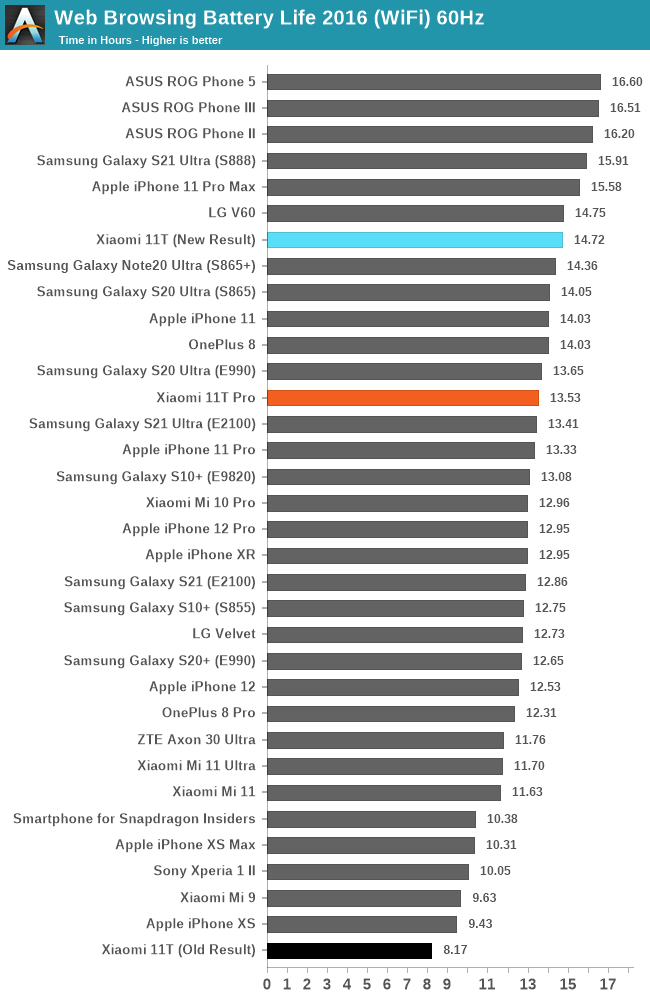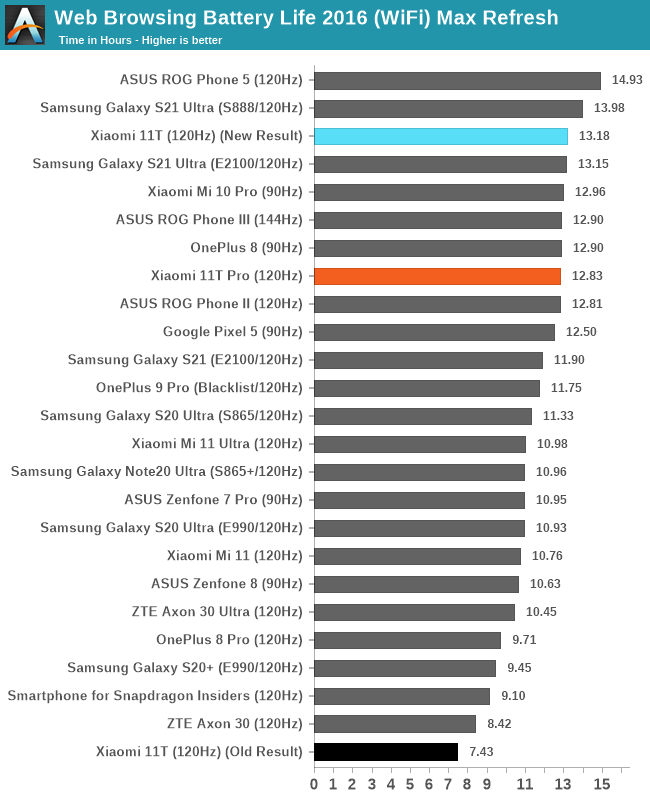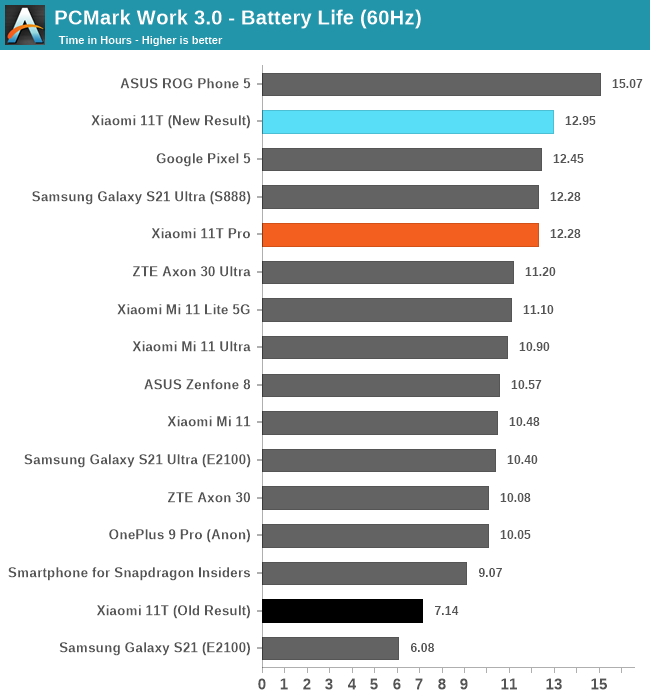The Xiaomi 11T & 11T Pro Review: Two Chips, With a Battery Focus
by Andrei Frumusanu on September 15, 2021 9:00 AM EST- Posted in
- Mobile
- Smartphones
- Xiaomi
- Xiaomi 11T
- Xiaomi 11T Pro
Battery Life
Battery comparisons between the 11T and the 11T Pro are again very interesting given the fact that we have to identical devices, only differing between each other in terms of SoC employed.
As noted in the earlier sections, there are a few differences in CPU behaviour, particularly the 11T Pro really not using the Cortex-X1 cores of the Snapdragon 888 too much. However, the 2.41GHz A78’s of the Snapdragon 888 are only 5% slower than the 3GHz A78 of the Dimensity 1200 – due to Qualcomm’s larger CPU and system caches, and better memory latency. So in terms of performance, as we noted before, the Snapdragon 888 11T Pro should still exceed that of the 11T, so it’ll be still somewhat valid comparison even without the X1 cores.


Update September 17th: Our 11T sample received a software update the day of the review embargo – we retested our initial battery life results and have seen significant improvements over the initial review firmware. We’re in the process of redoing all the battery life tests and will update the review to reflect the updated experience.
In the web browsing tests, the results couldn’t be more different, and the discrepancy between both phones frankly shocked me.
The 11T with the MediaTek SoC only managed to get 57-60% of the battery life of the Snapdragon 11T Pro. Again, I have to emphasise that these two devices are otherwise identical – same battery capacity, and same screen, and I haven’t been able to measure any difference in power between the two phones at the same screen brightness. What this means, is that the delta here seems to be related to the SoC.


In PCMark as well, the 11T is only showcasing 58-61% of the longevity of the 11T Pro, all whilst showcasing worse performance numbers.
The results for the 11T both in the web test and in PCMark are just abysmal. I did run power analysis on all the CPUs in SPEC, and yes, the Snapdragon 888 is quite a lot more energy efficient than the Dimensity 1200, however not to a degree to actually end up with such a large battery life discrepancy – at least not that I would assume.
The 11T was noticeably warmer than the 11T Pro in the battery tests, which is kind of obvious given that it evidently uses more power. For me, the MediaTek powered 11T is dead in the water, as the results here are just too bad.
The 11T Pro’s battery life was good, and what surprised me the most is that it’s the only non-Samsung Snapdragon 888 phone that didn’t exhibit terrible baseline power consumption. I’m not sure what to attribute this to, but it ends up with quite good results, though still lagging behind the S21 Ultra with its much more efficient display.
Update September 17th: Our 11T sample received a software update the day of the review embargo – we retested our initial battery life results and have seen significant improvements over the initial review firmware. We’re in the process of redoing all the battery life tests and will update the review to reflect the updated experience.
Update September 22nd: The new battery tests have been completed and updated. The 11T with the MediaTek SoC now represents the expected battery life results out of the chip, showcasing slightly longer battery life compared to the Snapdragon 11T Pro. In terms of absolute results, they’re very good compared to other comparative 120Hz powered devices, and both 11T and the 11T Pro showcase excellent longevity.










41 Comments
View All Comments
beginner99 - Thursday, September 16, 2021 - link
Hence you should disable fast charging and only enable it when your really need it. Plus not go below 20% too often and not leave it plugged in at 100% overnight.philehidiot - Thursday, September 16, 2021 - link
Myself I have a balance between battery and lifestyle. I'm not rearranging my life around battery longevity and I've a local phone shop that does reasonably priced battery swaps. You lose waterproofing, though. I slow charge with a slow wireless charger overnight (to preserve the USB port which is a known weakness on my phone) and have "fast cable charging" disabled. So when I go on holiday, I take a normal wired charger and the super fast one. The super fast cable charging is enabled but there's no way of mixing it up as it's the only time I ever use that charger and I have to consciously get it. When you're in a rush, the last thing you want to do is mess around with charging options.It's not the most optimal solution for battery life, but I also bought a phone with a battery that would easily last a day and a half when I got it, so there is room to drop before it really impacts my routine.
I'll be very interested to see what this article has to say on the effect of fast charging on battery life. It's infuriating that people just aren't aware of the problems to the point that they'll actively challenge something that has been well established for decades - fast charging repeatedly damages batteries.
timecop1818 - Wednesday, September 15, 2021 - link
xiaomi makes a lot of USB power banks, so they should have experience with high charge/discharge battery cellsssdj - Thursday, September 16, 2021 - link
Xiaomi has a share in sunwoda, world's leading battery manufacturer on par with coslight.abufrejoval - Wednesday, September 15, 2021 - link
Well, it is becoming more and more difficult to achieve the miracles vendors want to sell and consumers want to brag about...But will consumers be unhappy with these devices, even when they are throttled to where they no longer burn their fingers (and the battery)? Probably not.
The main message for me is: Little benefit from new devices in terms of performance.
Limited battery life time, ever more fragile devices and limited software support unfortunately won't let us just keep our existing phones until things get interesting again.
GC2:CS - Wednesday, September 15, 2021 - link
Well thanks for your work an article on those FTL charging methods would be greatly appreciated.I do have a suspicion that something is wrong with "charges in 15 minutes and 120W in phone thing" when the basics are still lithium ions and cobalt oxide housing. They do not like high currents and high temperatures. And nobody talks about negatives. All I see is fanboys screaming "ur phone charges slower than a snail !"
So a thorough deep dive would be appreciated. Should I charge my notebook at 5W then ?
dragosmp - Wednesday, September 15, 2021 - link
Probably not at 5, but not at 120W either. For every battery chemistry and build quality there is a "maximum" charging speed for which there is no heat accumulation and no separator damage. If it's a "power" cell, aka a cell with a thinner and more permeable separator, then you can charge at higher power, but you get less Wh per volume. Power cells also tend to get higher self-discharge. At 5000mAh, so 5Ah, for an average 3.8V, 1C charging is 18W. 18W is surely safe, and probably somwere between 18 and 36W is safe too below 80% SoC. For more than that, it depends on the cell, heatsink/phone and charging curve - which is why I'm with Andrei on testing the battery inside the phone, as opposed to on a table with open airflow and maybe too keeping temps in check.Wrs - Wednesday, September 15, 2021 - link
There is already so much one can do with lithium and cobalt (or manganese sometimes).. what it boils down to is how good the design is and how well it's manufactured. Remember years back when we worried about whether 15W quick charging would lead to shortened lifespan compared to 5W charging? You could say back then designs were less advanced - production methods were not as refined, and the product has to be perfect btw, one mistake and a fire erupts in someone's pocket.I'm of course curious about how much degradation happens at 120w peaks compared to 15 or 25w. Someone will have to test that long-term. And then we'll have to ask whether that's significant or practically meaningful. Degradation is not really a fixed percentage; it's more like an added resistor to the battery. Draw high testing current and you'll see much higher % aging than if you draw low current. All that is relative to battery size. That's why Apple had that "fiasco" with performance throttling on older iPhones. Their battery designs tend to be smaller and more conservative (less cutting-edge). I will say I appreciate seeing a contrasting manufacturer who keeps pushing the edge - all this research prepares us for what we might see as standard tomorrow.
NextGen_Gamer - Wednesday, September 15, 2021 - link
Small (but funny typo): after making a point of talking about how Xiaomi has dropped the Mi branding from the 11T series, you then proceed to call them just that in the spec comparison table right afterwards hahaAndrei Frumusanu - Wednesday, September 15, 2021 - link
Thanks, I had written the header table before Xiaomi emphasised the Mi removal.